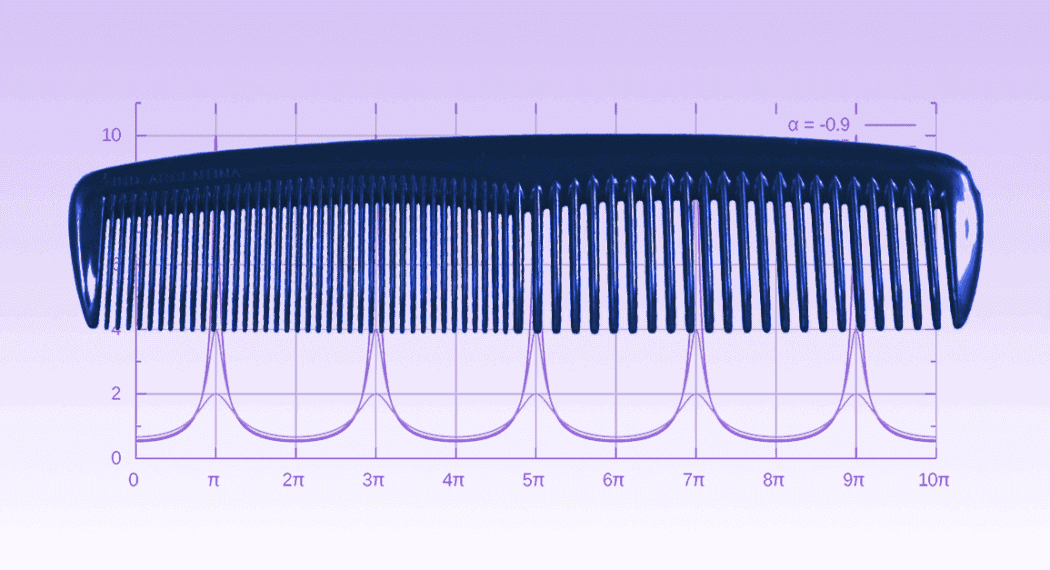A necessary one to know is known as comb filtering. It’s a novel phenomenon that’s generally used as an audio effect—however, can even wreak havoc in your combine.
In this article, I’ll unpack the period, clarify the place it’s helpful and the place you’ll want to keep away from it in your workflow.
Let’s get began.
What’s comb filtering?
Comb filtering is a type of damaging interference that happens when very comparable alerts mix collectively.
For instance, think about a single repeat delay on a observe in your DAW. If the delay time is brief sufficient, the 2 alerts will overlap significantly.
The cancellation from the small-time variations between the alerts happens in a predictable sample of peaks and troughs that resembles a fine-tooth hair comb.
Comb filtering appears like a crunched, metallic model of the unique sign with sturdy harmonics that may sound harsh.
Which will sound prefer it has no musical purposes by any means, however, inventive engineers have discovered loads of methods to make use of the impact.
For instance, It’s the premise of the flanger type of modulation effect.
However, regardless of these musical makes use of, unintentional comb filtering can nonetheless trigger issues in a mixture.
Comb filtering appears like a crunched, metallic model of the unique sign with sturdy harmonics that may sound harsh.
I’ll break down how they happen and what you can do to repair them later on in this article.
Flanger results
Let’s begin easy—an utility of comb filtering that you simply would possibly acknowledge is the sound of a flanger impact.
It’s the acquainted whooshing jet-plane noise typically heard on distorted guitar or studio drums.
First used within the late 60s, the unique flanging impact got here from two synced tape machines playing the same audio material.
When summed along with a mixer, the engineer would apply slight strain to the “flange” of the tape reel to decelerate the velocity of 1 machine.
Because it modified the velocity of the second machine, the frequencies affected by the comb filtering would shift, making a hanging kind of modulation.
The ensuing sound is the psychedelic impact that we heard on traditional recordings from the 60s and 70s:
Later, engineers used bucket brigade chip know-how from analog delays to create identical outcomes.
In some instances, a slight delay between the 2 alerts signifies that they don’t overlap completely. As a substitute of stacking collectively, the delay causes them to cancel out.
This time, they used an LFO to modulate the delay time as a substitute for the engineer’s finger. To boost the impact, a few of the shifted sign was routed again to the flanger’s entrance. This suggestion—or ‘regen’ because it’s generally labeled—is chargeable for the traditional jet aircraft sweep.
At the moment’s flanger plugins are primarily based on this idea however embody fashionable conveniences like tempo-synced sweep, width or depth controls, and LFO waveshape.
Right here’s a couple of enjoyable flanger plugins you’ll be able to attempt to hear this impact:
Bodily modeling synthesis
Some methods of synthesizing sound are primarily based on simulating actual-world behavior with physics.
One such approach is known as Karplus-Sturdy synthesis. The identity sounds futuristic, nevertheless, it’s only an intelligent solution to imitate a string such as you’d discover on a guitar or violin.
This synthesis kind depends on comb filters to work.
From there issues get difficult, however, there are many nice explainers elsewhere on the net in case you’re.
In the event you’re an Ableton Live Suite proprietor you’ll be able to experiment with one of these syntheses by utilizing the Tension plugin—it’s an important introduction to what this strategy can do! Or if in case you have a replica of FL Studio you can do the identical with the distinctive Sakura synth.
Harmful comb filtering
With the musical making use of out of the best way, I’ll break down the kind of comb filtering you wish to keep away from in your combine.
That is the damaging interference that leads to tinny, filtered sound. Right here’s wow it occurs.
Reflections off the onerous surfaces within the setting the place you document can even result in comb filtering.
Comb filtering can happen any time that makes two associated alerts blend collectively. I’m speaking about alerts that might be comparable sufficient that they’re nearly like copies of each other.
You’ll be able to encounter this case every time you document a supply with a couple of microphones. It could additionally occur whereas utilizing a DI box in addition to a microphone to document one thing like a bass guitar.
In some instances, a slight delay between the 2 alerts signifies that they don’t overlap completely. As a substitute for stacking collectively, the delay causes them to cancel out.
Take the time to hearken to associated sources rigorously earlier than you document. In the event, you acknowledge a comb filtering impact. You might have to maneuver one of many microphones or change the best way you document.
Along with that, reflections off the onerous surfaces within the setting of the place you document can even result in comb filtering.
For instance, think about you’re recording vocals in a small room with no acoustic treatment. The primary reflection that bounces off a close-by wall combines with the direct sound of your voice when it reaches the mic.
Even this small-time delay can lead to comb filtering as the 2 alerts mix on the microphone.
Attempt to keep away from establishing your mics too near onerous surfaces like partitions and ceilings. Or higher but, create a DIY vocal booth to cut back reflections in your house.
Bizarre audio results
Comb filtering is a bizarre quirk of sound physics, nevertheless, it has an actual impact on your sound.
In the event you’ve ever questioned why two alerts don’t mix the best way you anticipate, you might need already skilled it.
However, comb filtering is simple sufficient to keep away from if you already know why it occurs.
In the event you’ve made it via this text, you’ll have a transparent concept of finding out how to take care of it.


